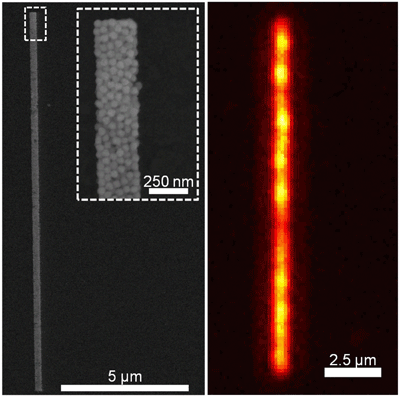Rice University researchers show how far nanoparticle chains can carry a signal
Mike Williams
713-348-6728
mikewilliams@rice.edu
Microscopic channels of gold nanoparticles have the ability to transmit electromagnetic energy that starts as light and propagates via “dark plasmons,” according to researchers at Rice University.

A scanning electron microscope image, left, shows a 15-micron line of 50-nanometer spherical gold nanoparticles. At right is a fluorescence image of the same chain, coated with a thin film of Cardiogreen dye using 785 nm laser excitation. (Credit Link Lab/Rice University)
A new paper in the American Chemical Society journal Nano Letters shows how even disordered collections of nanoparticles in arrays as thin as 150 nanometers can be turned into waveguides and transmit signals an order of magnitude better than previous experiments were able to achieve. Efficient energy transfer on the micrometer scale may greatly improve optoelectronic devices.
The Rice lab of Stephan Link, an assistant professor of chemistry and electrical and computer engineering, has developed a way to “print” fine lines of gold nanoparticles on glass. These lines of nanoparticles can transmit a signal from one nanoparticle to the next over many microns, much farther than previous attempts and roughly equivalent to results seen using gold nanowires.
Complex waveguide geometries are far easier to manufacture with nanoparticle chains, Link said. He and his team used an electron beam to cut tiny channels into a polymer on a glass substrate to give the nanoparticle lines their shape. The gold nanoparticles were deposited into the channels via capillary forces. When the rest of the polymer and stray nanoparticles were washed away, the lines remained, with the particles only a few nanometers apart.

Members of the lab of Rice Professor Stephan Link – from left, research associate Wei-Shun Chang and graduate students David Solis Jr. and Britain Willingham – created thin strips of gold nanoparticles to study their ability to carry electromagnetic signals via dark plasmons. (Credit: Jeff Fitlow/Rice University)
Plasmons are waves of electrons that move across the surface of a metal like water in a pond when disturbed. The disturbance can be caused by an outside electromagnetic source, such as light. Adjacent nanoparticles couple with each other where their electromagnetic fields interact and allow a signal to pass from one to the next.
Link said dark plasmons may be defined as those that have no net dipole moment, which makes them unable to couple to light. “But these modes are not totally dark, especially in the presence of disorder,” he said. “Even for the subradiant modes, there is a small dipole oscillation.
“Our argument is that if you can couple to these subradiant modes, the scattering loss is smaller and plasmon propagation is sustained over longer distances,” Link said. “Therefore, we enhance energy transport over much longer distances than what has been done before with metal-particle chains.”
To see how far, Link and his team coated the 15-micron-long lines with a fluorescent dye and used a photobleaching method developed in his lab to measure how far the plasmons, excited by a laser at one end, propagate. “The damping of the plasmon propagation is exponential,” he said. “At four microns, you have a third of the initial intensity value.
“While this propagation distance is short compared to traditional optical waveguides, in miniaturized circuits one only needs to cover small length scales. It might be possible to eventually apply an amplifier to the system that would lengthen the propagation distance,” Link said. “In terms of what people thought was possible with nanoparticle chains, what we've done is already a significant improvement.”
Link said silver nanowires have been shown to carry a plasmon wave better than gold, as far as 15 microns, about a sixth the width of a human hair. “We know that if we try silver nanoparticles, we may propagate a lot longer and hopefully do that in more complex structures,” he said. “We may be able to use these nanoparticle waveguides to link to other components such as nanowires in configurations that would not be possible otherwise.”
Graduate student David Solis Jr. is the lead author of the paper. Co-authors are graduate students Britain Willingham, Liane Slaughter, Jana Olson and Pattanawit Swanglap, junior Scott Nauert and postdoctoral research associates Aniruddha Paul and Wei-Shun Chang, all of Rice.
The research was supported by the Robert A. Welch Foundation, the Office of Naval Research, the National Science Foundation, the American Chemical Society Petroleum Research Fund and a 3M Nontenured Faculty Grant.
Read the abstract at http://pubs.acs.org/doi/abs/10.1021/nl2039327
Advertisement
Learn more about Rice University





